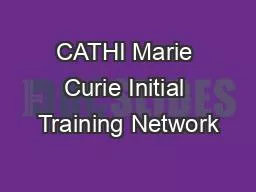

C ryogenics A ccelerators and T argets at H IE I SOLDE Alejandro G Sosa a lejandrogarciasosacernch BEBIPM WP 2 ESR 3 Mid Term Review Meeting 26 September ID: 802146
Download The PPT/PDF document "CATHI Marie Curie Initial Training Netwo..." is the property of its rightful owner. Permission is granted to download and print the materials on this web site for personal, non-commercial use only, and to display it on your personal computer provided you do not modify the materials and that you retain all copyright notices contained in the materials. By downloading content from our website, you accept the terms of this agreement.
Slide1
CATHIMarie Curie Initial Training Network Cryogenics, Accelerators and Targets at HIE-ISOLDE
Alejandro G. Sosaalejandro.garcia.sosa@cern.ch(BE-BI-PM)WP2, ESR 3Mid-Term Review Meeting, 26 September 2012
Slide2OutlineBackgroundActivity at CERNProject Status PublicationsTrainingOutreach ActivitiesTechnical Visits
Slide3Background2009Master’s Degree in Physics – Minor in Digital Electronics and Control Systems.University of Oviedo, SPAIN2010-2011Research Assistant at the University of Oviedo in two different projects:
1- Development of non-destructive technology to estimate the erosion of refractory brick in blast furnaces (FUO-EM-055-10).
2- Time Domain Electromagnetic mapping and prospecting.
Slide4Activity at CERNTaking measurements to test the HIE-ISOLDE Faraday cup prototype using pilot beam.
Running simulations on CST Particle Studio to assess the performance of the HIE-ISOLDE Faraday cups.Characterization of the MCPs at REX-ISOLDE as a beam position monitor.
Tested a Si PIN photodiode in REX-ISOLDE to be used in EBIS time of flight measurements.
Collaborated in emittance studies at REX-ISOLDE with different beam energies and beam shapes.
Slide5Project StatusCharacterizing the HIE-ISOLDE Faraday cup, working on possible improvements.A prototype of the HIE-ISOLDE Diagnostic boxes will arrive at CERN next month from AVS. Preparation of tests under way.Deciding the best locations for the first Si detectors during stage 1 of the upgrade in order to assess their performance and radiation tolerance.
Slide6Publications“Beam Instrumentation for the HIE-ISOLDE Linac at CERN” (CERN-ATS-2012-091) Presented at IPAC 2012 (New Orleans, USA).A. Sosa, E. Bravin, M.A. Fraser, J. Galipienzo, Y. Kadi, A. Larman, D. Voulot, C.P. Welsch, F.J.C. Wenander, F. ZoccaPIN Photodiode test report on the REX-ISOLDE post-accelerator. EDMS document 1238408 v.
1, August 2012.A. Sosa, E. Bravin, S. Burger, E. Cantero, D. Lanaia, D. Voulot, F.J.C. Wenander, F. Zocca
Slide7TrainingStarted a PhD in Accelerator Physics at the University of Liverpool, UK. February 2012.Joint Universities Accelerator School (JUAS). January - March 20124th DITANET School on Advanced Career Skills. University of Liverpool, UK. May 2012.(Quantum Systems and Research at Accelerators) DITANET Symposium at the Cockcroft Institute. Daresbury, U.K. 16 May 2012.General French courses at CERN. May – July 2012
Slide8Outreach ActivitiesCERN guide.“Get curious series - Marie Curie ITNs in a nutshell” video
Slide9Technical VisitsATLAS, CMS, SM18, LINAC2 facilities at CERN.
PSI Laboratory, Villigen, Switzerland.ESRF. Grenoble, France.
Cockcroft Institute. Daresbury, UK.
Slide10ConclusionsI think this training network is an incredible experience, it is definitely boosting my researcher skills, and a solid work team has now been established.
Thank you so much for your attention!